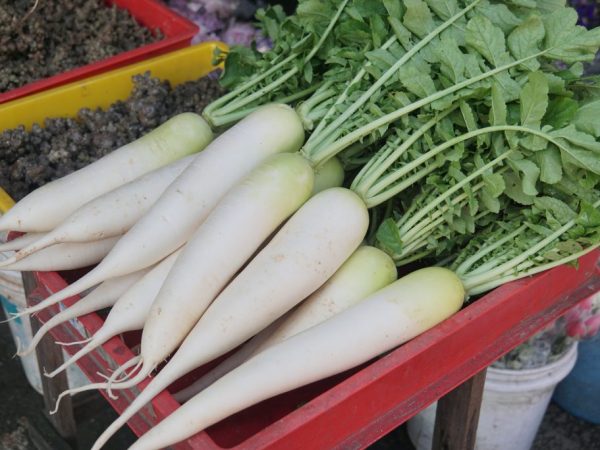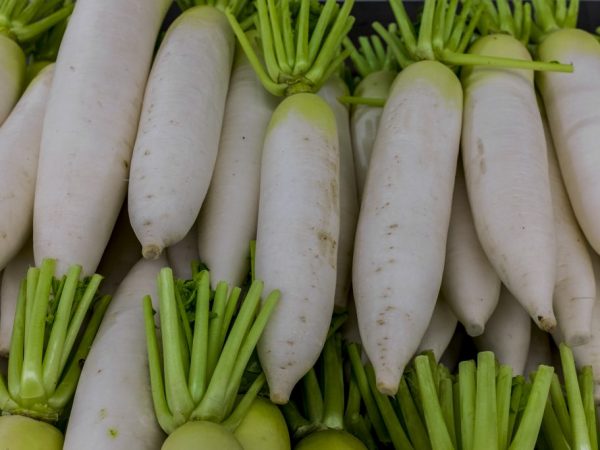White carrot
Carrots are a common garden crop that yields good yields and are undemanding to growing conditions. The fruits are widely used in cooking: they contain a lot of vitamins and nutrients. White carrot is one of the most popular varieties among gardeners, which differs from others in the structure of the fruit.

White carrot
Characteristic
White carrots are named for the color of their roots. She acquired a shade due to the absence of beta-carotene in the composition.
The plant belongs to the umbrella group. The white vegetable looks like a wild parsnip.
Description of the variety
White carrots have many health benefits and are low in calories. It contains many B vitamins, as well as retinol, niacin and geranol, which have an antibacterial effect.
The following trace elements are present in white carrots:
- aluminum;
- iodine;
- vanadium;
- cobalt;
- boron;
- iron;
- fluorine;
- copper;
- zinc;
- nickel.
Description of the bush
The top of the White Carrot is no different from that of the classic orange varieties. It has a lush and strong tops, reaching a height of 50 cm.
The leaves are large, their length is 20-30 cm. They have a bright green color, dense and elastic. The plant is good against fungal diseases and leaf spot.
Description of fruits
The root crops of the variety also differ little from other varieties, with the exception of the white color of the carrot, which is why it is so called. It has a dense and juicy core, smooth and fleshy surface. The vegetable is 10-15 cm elongated in length.
White carrots taste crispy and sweet. There are many juices in it. Also, the fruits, due to the content of essential oils, have a pleasant aroma. The beneficial properties of the fruits allow them to be used in medicine.
Growing

Carrots love loose soil
Planting white carrots is best done in light soils. The plant prefers loose soil with good oxygen and moisture access.
Seeds are best planted after:
- cucumbers;
- cabbage;
- tomatoes;
- Luke.
White carrots do not grow well after parsley or dill. Before sowing, the site is cultivated to a depth of 10 cm and organic fertilizer is applied, as well as phosphorus and potassium.
Disembarkation
To store root vegetables in winter, they are planted at the end of April and until mid-May. For summer use, the crop is planted in mid-autumn.
On the plot, a furrow is cut with a depth of 15-20 cm. The distance between the rows should be about 30 cm. Carrot seeds are mixed with sand for even distribution. Take a spoonful of planting material for 400 ml of sand.
To accelerate germination, seeds are soaked in warm water for 24 hours. Sown in spring white carrots emerge in 2-3 weeks.
Seeds are sown in prepared furrows together with sand and buried in a small layer of soil. Compost is added on top of the planting, which is lightly tamped.
Also, with high acidity of the soil, the following substances are introduced:
- lime;
- ash;
- a piece of chalk;
- dolomite.
Care
In the spring, planting protects from night temperature drops and strong winds.For protection, carrots are spud or covered with a covering material. Also, plantings are periodically thinned out so that there is at least 5 cm between neighboring plants.
White carrots are covered with agrofibre. This shelter maintains the required level of moisture and heat, and also protects against pests and diseases. When the plants become strong, the shelter is removed.
Fertilizer
The first fertilizer is applied a few days before planting. Potash and phosphate fertilizers, as well as humus and deciduous soil, are introduced into the soil.
Depending on the type of soil, White Carrots need the following substances:
- Clay and podzolic soil. Humus, peat and soaked sawdust are added to such soil. It also requires the introduction of nitrophosphates and superphosphates, 30 g per 1 m².
- Peat soil. It is required to add sawdust, humus and river sand. Superphosphates, urea and potassium chloride are added from the chemicals.
- Chernozem. River sand and sawdust are introduced into such soil. A small amount of superphosphates is also required.
- Sandy soil and sandy loam. Only nitrogen and phosphorus fertilizers are applied.
During the growing season of White carrots, 2 dressings are applied:
- with 1 feeding, 60 g of potassium, 50 g of nitrogen and 40 g of phosphorus are added;
- at 2 top dressing, 20 g of nitrate, 30 g of superphosphate are introduced.
In addition to nitrogen and phosphates, the culture needs potassium salts. Complex preparations with chlorine content are also introduced.
Be careful when applying nitrogen fertilizers. An incorrectly selected amount of substance in the solution causes the death of the root system and drying of the tops. Nitrogen fertilizers are applied only in the aisles in the form of a liquid.
Watering
White carrots are a moisture-loving plant. Moisture is applied once a week in normal weather. In dry weather, water is watered every 5 days, and in the rainy season, the introduction of moisture is reduced or stopped.
With a lack of water in the soil, the fruits are deformed, dry up and crack. For irrigation, use only clean liquid that has been heated in the sun.
Diseases and pests
White carrots have good immunity to viruses and harmful insects, but there is a risk of leaf discoloration. Also, the culture is affected by the carrot fly.
Pest control is carried out using an integrated method. The soil is dug up after harvesting to destroy all residues from the bushes.
Treatment of diseases
Phomosis is a common disease of white carrots. To prevent it, potassium chloride is added to the soil during autumn processing. It is also used for feeding 15 days before harvest.
When stored, the fruit can get sick with powdery mildew. To prevent this, potash fertilizers are applied during cultivation, and during storage, the crop is covered with a layer of sand.
Getting rid of pests
The carrot fly makes the fruit unfit for human consumption. To combat it, plants are treated with insecticides several times during the growing season.
Folk remedies give the same effect. Onion husks, tobacco dust and ash help from pests.
Prophylaxis
To prevent the disease, the plant is treated with nettle infusion. The plant is brewed in boiling water and added to the water when watered.
Also, the bushes are sprayed with Immunocytophyte and other bioactive agents that improve the immunity of the plant. For prevention, carrots are processed in June.
Conclusion
The beneficial properties of the vegetable make it possible to use it to cleanse the blood and normalize the work of the cardiovascular system. Tea is also made from the tops.
The White Carrot has several varieties, among which the most popular are Belgian, Lunar and Satin. Root vegetables are used both raw and cooked.


